Showing 1061–1070 of 1165 results

An anthology of over 90 articles penned by the renowned Sanskritists and Indologists in order to felicitate Prof. Vachaspati Upadhyaya covers different domains of Indian intellectual tradition, emphasizing upon the dialectical depth and thematic width of Indian philosophy, religions and culture enshrined in Sanskrit sources.
Vacaspativaibhavam is a modest tribute to the dynamic persona of Professor Vachaspati Upadhyaya whose chequered career spans more than four decades. In this volume, an earnest endeavour is made to collect and recollect his significant contribution to the academic world, both as a scholar as well as an administrator.
The first part of this volume carries benign blessings of saints and scholars for the unbound showering of divine grace upon Professor Upadhyaya. Many messages by the dignitaries and copious compliments from well-wishers and friends of Professor Upadhyaya convey his unmitigated commitment to the core human values cherished in his heart.
The second section of the volume comprises rich reminiscences penned by a vast majority of his colleagues and students from all over the country. These memoirs, in the form of personal reflections, are richly expressed through the medium of poetry and prose, and reveal the various aspects of the multifaceted personality of Professor Vachaspati Upadhyaya.
More than ninety research papers included in the principal part of the volume are not limited to the narrow compartmentalization of a particular subject but cover different domains of Indian intellectual tradition. Authored by a galaxy of scholars, Indian and foreign, these articles not only highlight the new ventures in cross-disciplinary studies, but also emphasize their basic concern with contemporary challenges facing humanity. The readers will relish that contributors to the volume have effectively reflected upon the dialectical depth and thematic width of Indian philosophy, religion and culture enshrined in Sanskrit sources.
In fine, the volume in hand promises to provide meaningful material for thought in the fields of Sanskrit and Indological Studies.
Vada, meaning debates, dialogues, discussions, was the quintessential of Indian spirit, enabling and promoting the growth of different philosophical and knowledge systems of India. It percolated deep into our mindset and enriched the moral, ethical, religious and sociocultural edifice of anything that was essentially Indian in nature. As continuation of Anvikshiki from the bc era, vada helped thrive Indian traditional knowledge systems. It subsists on diversity and its tradition envisages pluralism.
Most of our Sanskrit works, covering a wide gamut of knowledge systems, are structured in the techniques of debate. This reality applies not only to the philosophical writings, but to Indian medical systems (Ayurveda), Arthashastra of Kautilya and Kamasutra of Vatsyayana as well. Even great epics like Ramayana and Mahabharata are no exceptions.
Vada culture involved verbal duals, attacks and even violence of speech, and all major religious systems — old or modern — were parties to it. This book also elucidates how vata was vital and critical for the growth of our socio-political fabrics. It shows how some of the major conflicts in philosophical systems were centred around karma, jnana, choice between violence and non-violence, pravritti and nivritti. It also presents the manifestations of vada on a vast canvas during the nineteenth and twentieth centuries. Modern spiritual and religious gurus like Ramana Maharshi, J. Krishnamurti and Vinoba Bhave were men of dialogues. Our scholars have applied the varied techniques of vada against the philosophical and scientific systems of the West to prove them correct.
This collector’s issue should enthrall a wide audience of philosophers, scholars and believers in Indian knowledge systems.

This book deals with the basic rituals performed in religious rites related to Grihya and Smartakarma, and covers Samskara religious activities to be observed by the Brahmacàrins, marriage rituals, the duties of the newly-wed couples, domestic rituals, Sraddhakarma, Rajodharma, an elucidation of Gayatri-mantra the significance of Prana and Vyahritis and the mode of worship of Lord Vishnu and Shiva with Purushasukta.
The Vedhulagrihyagamavrittirahasyam of Narayana Misra is a versified commentary on the Vadhulagrihyasutravritti, which itself is a short commentary on the Vadhulagrihyasutra. It deals with the basic rituals performed in religious rites related to Grihya and Smartakarma. The text mainly deals with Samskara, religious activities to be observed by the Brahmacarins, marriage rituals, the duties of the newly-wed couples and several other religious and domestic rituals. The last two chapters deal exclusively with Sraddhakarma and Rajodharma, respectively. It includes an elucidation of Gayatri-mantra according to Acarya Sankara, the significance of Prana and Vyahrtis and the mode of worship of Lord Vishnu and Shiva with Purusasukta. The significance of Vadhulagrihyagamavrittirahasya is in not just what it contains but also in the fact that it refers to many unknown texts, such as Prayogaklripti, Katha-Aranyaka, Vadhulagam and Vrata Sangraha.
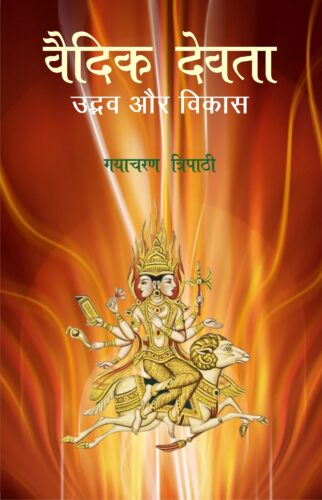
Present book presents interesting and authentic details of almost all promient Vedic gods, about their conceptions, their most ancient forms, their orderly evolution, and about their evolved personalities.
There have been quite a few attempts to delineate the nature and character of Vedic Deities on the basis of Vedic Samhitas by European scholars like Macdonell, Hillebrandt, Oldenberg, Luders and, of late, by Oberlies, etc. However, none of these scholars has made attempt to trace the subsequent development of their character and personalities through the later Vedic texts, epics and the Puranas, etc., whereas it goes without saying that the concept of Hindu gods today in the minds of the people is exactly the one which we encounter in the Puranas and in the folk literature.
This obviously means that the personalities of the Vedic Deities did not freeze with the end of Vedic literature but continued to develop in later period as well through the subsequent literarary activities. Taking rather vague clues from the Vedic texts, the authors or narrators of the Puràõas, augmented and supported by folk beliefs, further expanded, modified and developed the personalities of these gods so that, for the most part, the intangible character of these gods acquired a concrete shape and form, a body of flesh and blood, so to say.
The book tries to trace the historical development of the personalities of Vedic Deities through the subsequent Vedic literature, as well as the epics and the Puranas till they acquire the shape and form in which they are conceived and venerated today.
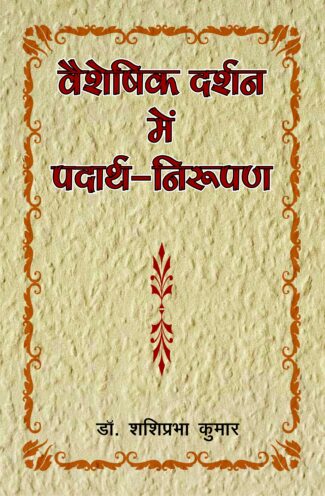
The present work is an encyclopaedic and authentic source for the study of Vaisesika, an important system of Indian philosophy. A comprehensive volume on the exposition of categories is worth obtaining by every library and each serious student of Indian thought.
Vaisheshika Darshana mein Padartha Nirupana (Exposition of Categories in Vaisheshika Philosophy) is an encyclopaedic work dealing with the metaphysics of Vaisheshika system of Indian Philosophy. This work takes up an extensive study of the categories of Vaisheshika and deeply analyses each one of them in well-structured manner. This is the most comprehensive book in Hindi which brings out the important contribution of Vaisheshika philosophy in an authentic way. So far, no other work has presented all the aspects of Vaisheshika as a central theme with the detailed analysis of its subsidiary principles in such an inclusive style.
This volume discusses the development of thought in Vaisheshika as well as the historical chronology of its scholars. It specially highlights the views of medieval thinkers of the Vaisheshika system who had hither to been ignored. The first edition of the present work was published from Publications Division, University of Delhi in 1992 and the second edition is now published through the scheme ßRepublication of Unavailable and Rare Textsû of the Rashtriya Sanskrit Sansthan, New Delhi.
This work is an invaluable for the in-depth study of Vaisheshika philosophy and is worth to be obtained by every library and is a wealth of information for all the students of Indian philosophy.
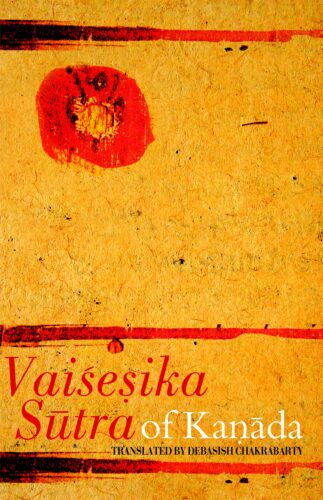
This book presents a lucid English translation of the Vaisesika-Sutra of Kanada, termed the earliest exposition on physics in Indian philosophy and the textual basis for the Nyaya-Vaisesika and Navya-Nyaya systems of thought. The translation retains the feel of the original sutras even while conveying the intended meaning accurately and with clarity.
Kanadas Vaisesika Sutra, the textual basis for the Nyaya-Vaisesika system and the later Navya-Nyaya system, may be termed the earliest exposition on physics in Indian philosophy. It presents one of the earliest discussions on the idea of atomicity and on the true nature of knowledge as comprising the categories of dravya (substance), guna (attribute), karma (action), samanya (generality), visesa (particularity) samavaya (inherence) and abhava (non-existence). This book presents the original Sanskrit text of the Vaisesika Sutra along with its Roman transliteration and a translation in the English language. The lucid translation is a scholarly attempt to retain the feel of the original sutras while conveying the intended meaning accurately and is easy to comprehend owing to many special features. Additional words are added in the translated text for the benefit of syntax but they are placed in parenthesis. The translated text has sub-titles that aid in simplifying the arguments by grouping the sutras. Besides, footnotes are provided to explain technical terms and concepts in the original Sanskrit. The book, published under the Shastra Group of Centre of Linguistic and English at Jawaharlal Nehru University which had earlier brought out the Yogasatra of Patanjali, will prove useful to all researchers and students of ancient Indian philosophy.
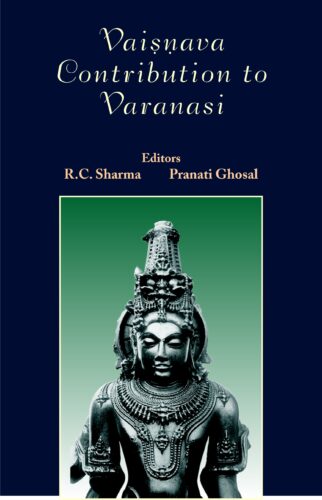
Varanasi, the abode of Lord Shiva has also embraced other sects including Vaisnavism. If Shiva is Nataraja or Natesha, Krishna is known as Natavara dancing with gopis. There are traditions which reveal that Kashi was once a Vaishnava stronghold. The book projects the Vaishnava contribution to Varanasi in literature, sculptural and other artistic renderings, visual and performing arts, temples, festivals and ceremonies.
Varanasi, the abode of Lord Shiva has also embraced other sects including Vaisnavism. If Shiva is Nataraja or Natesha, Krishna is known as Natavara dancing with gopis. There are traditions which reveal that Kashi was once a Vaishnava stronghold. In the medieval period many Vaishnava saints from different quarters thronged to Varanasi to preach and popularise their faith. The book projects the Vaishnava contribution to Varanasi in literature, sculptural and other artistic renderings, visual and performing arts, temples, festivals and ceremonies.

The three scholarly volumes contain an iconographic analysis and compilation of the over 760 images from the six chapels of the Pao-hsiang Lou in the Forbidden City, Beijing. There are details of each image like name in Sanskrit, Tibetan and Chinese; physical description; iconographical and stylistic features; and associated images.
The three volumes contain an iconographic analysis and compilation of the over 760 images from the six chapels of the Pao-hsiang Lou (Bao-xiang Lou) in the garden of the Tzu-ning Kung (Palace of Kindness and Tranquillity) in the Forbidden City, Beijing. The pavilion Pao-hsiang Lou, a two-storied simple structure with seven chapels on each floor, holds hundreds of Tibetan Buddhist images of remarkable quality. The volumes present the entire set of images, each reproduced and explained with great clarity. There are details of each image with regard to the physical description of the figure portrayed and its various iconographical and stylistic features and associated images. Each entry contains the name of the deity with the Sanskrit, Tibetan and Chinese transliterations of the name. The very interesting and useful introduction discusses deities of mandalas, placement of deities within a single chapel, images of the Pao-hsiang Lou pantheon compared to the Chu Fo Pu-sa Sheng Hsiang Tsan pantheon, variations in depiction of images with regard to their hair, crown and other parts and associated ornaments, and the asanas of the images. The scholarly volumes are a result of the painstaking research by the author by referring to noted experts on the subject. The volumes will interest all students and scholars of Buddhist art and iconography.
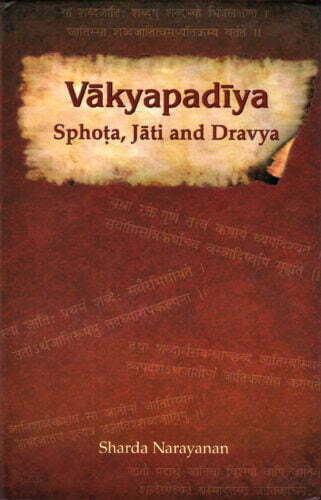
The book deals with the main contribution of Bhartrhari to the field of linguistic study and its impact on philosophy in general. Presenting a systematic study of the jati, dravya and bhuvodravya samuddeshas in the Vakyapadiya it also looks at the concept of jati in the philosophies of Nyaya and Mimamsa.
This research study is concerned with understanding the concept of jati and dravya in the Vakyapadiya of Bhartrhari.
The concept of jati is crucial to the enunciation of sphota, the single most outstanding contribution of Vakyapadiya to the field of language study. The concept, already connected with the import of a word in Nyaya-Vaisheshika and Mimamsa schools, was brought into the field of linguistics by Bhartrhari. This book traces the development of language study from the Vedic period to the darshanas. It deals with the main contribution of Bhartrhari to the field of linguistic study and its impact on philosophy in general. It then presents a systematic study of the jati, dravya and bhuyo dravya samuddeshas in the Vakyapadiya, explaining all the karikas. It also views the concept of jati in the philosophies of Nyaya and Mimamsa, its development over the centuries and the necessity of modifying some tenets owing to the sharp criticism from other schools especially Buddhism. The volume includes relevant quotations from Sanskrit texts and makes use of important commentaries like the Prakasha of Helaraja and Ambakartri of Pt. Raghunatha Sarma.
The scholarly work will prove invaluable to scholars and students of Indology, particularly those keen on studying Indian linguistic philosophy with special reference to Bhartrhari.

This book reconsiders Valmiki Ramayana from different perspectives literary, aesthetic, ethical, comparative, interdisciplinary, religious, philosophical, social, and archaeological among others. In the process, it underscores significance of Ramayana from modern perspective, as it unveils its multilayered worlds.
Valmiki Ramayana, the first kavya (poetic composition) and the first mahakavya (epic) of the world, is an inexhaustible fountain of culture and knowledge. It has impacted infinite minds and souls in India and abroad, and continues to inspire and engage creative and critical minds, and will remain so for the ages to come.
Ramayana, along with standardizing Ramakatha, transcends history, geography and binaries of mode of thinking. Its appeal may be discerned from the fact that it exists in different versions in various regions and forms. Notwithstanding these versions, Valmiki Ramayana rules human heart and mind for its subject matter and manner of articulation.
The multilayered worlds of Ramayana make it a seedbed of ideas existing at various levels. Traversing generations, and getting interpreted anew in consonance with cultural needs and existential questions, it has earned serious critical consideration of scholars from different perspectives literary, aesthetic, ethical, comparative, interdisciplinary, religious, philosophical, moral, social, archaeological, and intermedial among many. Hence, it demands its reinterpretation by every generation. The present book is a testimony to it, and a response in this direction.
Consisting of scholarly papers by eminent intellectuals and with a perspicuous introduction, this book reconsiders Valmiki Ramayana from different perspectives, presented in a seminar on Ramayana that was organized with the blessings of Pujya Morari Bapu.
| There are no products |